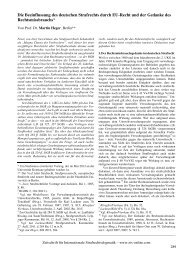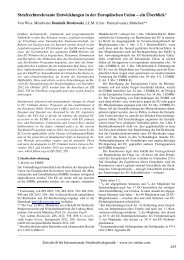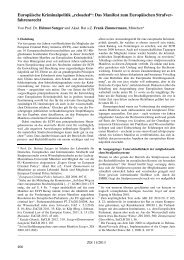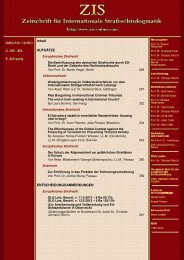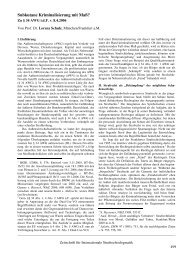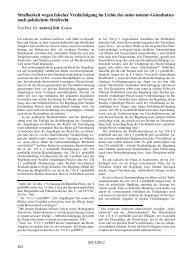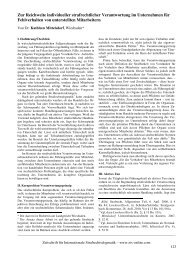Inhalt AUFSÄTZE ANHANG - ZIS
Inhalt AUFSÄTZE ANHANG - ZIS
Inhalt AUFSÄTZE ANHANG - ZIS
- No tags were found...
Create successful ePaper yourself
Turn your PDF publications into a flip-book with our unique Google optimized e-Paper software.
Harmen van der Wilt_____________________________________________________________________________________II. On the origins and nature of functional perpetration inDutch lawThe concept of functional perpetration is largely a jurisdictionalartifact, initially construed for economic offenses; ithas not been codified in statutory law. 8 The gist of the conceptentails that employers and managerial staff are capableof procuring economic offences by prompting others to executethe physical act. Functional perpetration reflects bothsocial/economic developments in Dutch society after WorldWar II and a – concomitant – different approach in criminallaw doctrine towards actus reus. Economic growth, propelledby active governmental interference, implied corporate expansionwith increasing functional diversification. A host ofnew legislation in the realm of safety regulations, fair competitionand foreign trade, augmented the risk of economicoffenses, while challenging the prevailing approach of ‘criminalperpetration’. The 19 th century doctrine of ‘willed bodilymovement’ appeared to be outmoded and inadequate, 9 as itignored that employers and managers, rather than their subordinates,had both the power to accomplish those offencesand reaped the benefits of ‘not sticking to the rules’. 10 Suchnew perceptions paved the way for the acceptance of a moreabstract and teleological interpretation of human action incriminal law. Not the assistant at the counter who sold taintedmeat to the customer, but the owner of the butcher shopshould incur criminal responsibility for violation of the Foodand Drugs Act. Not the truck driver who passed sleeplesshours at the steering wheel of his lorry should be held accountablefor breaching the regulations governing drivinghours, but his boss. It was gradually taken for granted thatthis new approach did not overstretch the meaning of actus8 Although special legislation, like the Act on Fertilizers(1947), explicitly refers to the concept by providing that‘selling’ includes ‘making someone to sell’, ‘offering’ includes‘making someone to offer’ and ‘delivering’ includes‘making someone to deliver’; see van Woensel, In de daderstandverheven; Beschouwingen over functioneel daderschapin het Nederlandse strafrecht (‘Elevated to Perpetration; Reflectionson Functional Perpetration in Dutch Criminal Law’),Arnhem, 1993, p. 84.9 In this sense G. A. van Hamel (revised by J.V. van Dijck),Inleiding tot de studie van het Nederlandsch Strafrecht (‘Introductionto the study of Dutch Criminal Law’), Den Haag1927, p. 187; ‘De daad is eene spierbeweging die zich vertoontals uiting van de wil’ (The act is a muscular movementwhich demonstrates itself as an expression of the will’.).10 As is well known, such ideas had been preceded by developmentsin German Legal doctrine, which equally questionedthe validity of mechanistic theories of action, compare HansWelzel’s Finale Handlungslehre (Studien zum System desStrafrechts, ZStW 58 (1938), 491.) For an English synopsisof Welzel’s views, see Fletcher, Basic Concepts of CriminalLaw, Oxford/New York, 1998, pp. 52 (53); on Welzel’s influenceon the structure of crime see also K. Ambos, Towarda universal system of crime: Comments on George Fletcher’sGrammar of Criminal Law, Cardozo Law Rev. 28 (2007)2647, at 2649 et seq.reus. On the contrary: depicting the indirect perpetrator as‘merely’ a participant was considered as somewhat contrived.The Dutch Supreme Court introduced the concept of‘functional perpetration’ in the so called ‘Iron wire’-case. 11 Inthis case, the owner of a one man’s business stood trial forhaving completed – through his export manager – a forgedform in order to obtain an export license for iron wire toFinland. The accused’ main defense was that he neither hadcompleted or had sent the form, nor had exported the merchandisehimself. The Supreme Court rejected the ratherbroad opinion of the Court of Appeal which had held that alladministrative acts which had been performed by a subordinatein accordance with his general assignment within theenterprise, could be attributed to the owner of a one man’sbusiness, irrespective of whether the latter was ignorant ofthose activities or not. Instead, the Supreme Court carefullydrew the limits of ‘functional perpetration’, by emphasizingthat “acts, such like these, as completing forms in violation ofthe law, sending those forms to the Import and Export Officeand the export of merchandise, could only then be qualifiedas ‘acts of the accused’, if he had the power of decisionwhether those acts occurred or not, and if those acts belongedto the realm of activities which the accused, as appearingfrom the general course of daily events, accepted or used toaccept.” 12The ‘power of decision’- and ‘acceptance’ standards havemade an impressive career in Dutch criminal law, as theycame to sustain the criminal responsibility for both legalentities and for those who are de facto in charge (factualleadership). 13 The power of decision connotes control andcommand over the acts, in the sense that the accused couldhave interfered in order to prevent them from happening. 14 Apower to prevent and stop the acts obviously implies a certainconsciousness of their (potential) occurrence, but the ‘acceptance’-standardwhich represents the subjective element ormens rea of the construction, does not require actual knowledgeof the specific acts that are charged. It suffices that theaccused was abreast of similar activities which were directlyrelated to those constituting the basis of the criminalcharge. 1511 Supreme Court, 23 February 1954, NJ 1954, 378.12 Ibidem, translation by the author.13 Corporate (criminal) liability and criminal responsibilityfor those who execute a leadership position within a corporateentity were officially introduced in Dutch Peal Code in1976.14 See B.V.A. Röling in his annotation of the ‘Iron Wire’-case. The standard is wider than ‘active instruction’, as theSupreme Court elucidated in a case in which a discothequestood trial – as a legal entity – for having discriminatedagainst Turkish customers. The latter had been refused entryby the gate keeper, Supreme Court, 14 January 1992, NJ1992, 413.15 See, in connection with criminal responsibility of de factoleadership: Supreme Court, 16 December 1986, NJ 1987, 321(Slavenburg(II) beschikking)._____________________________________________________________________________________616<strong>ZIS</strong> 11/2009




